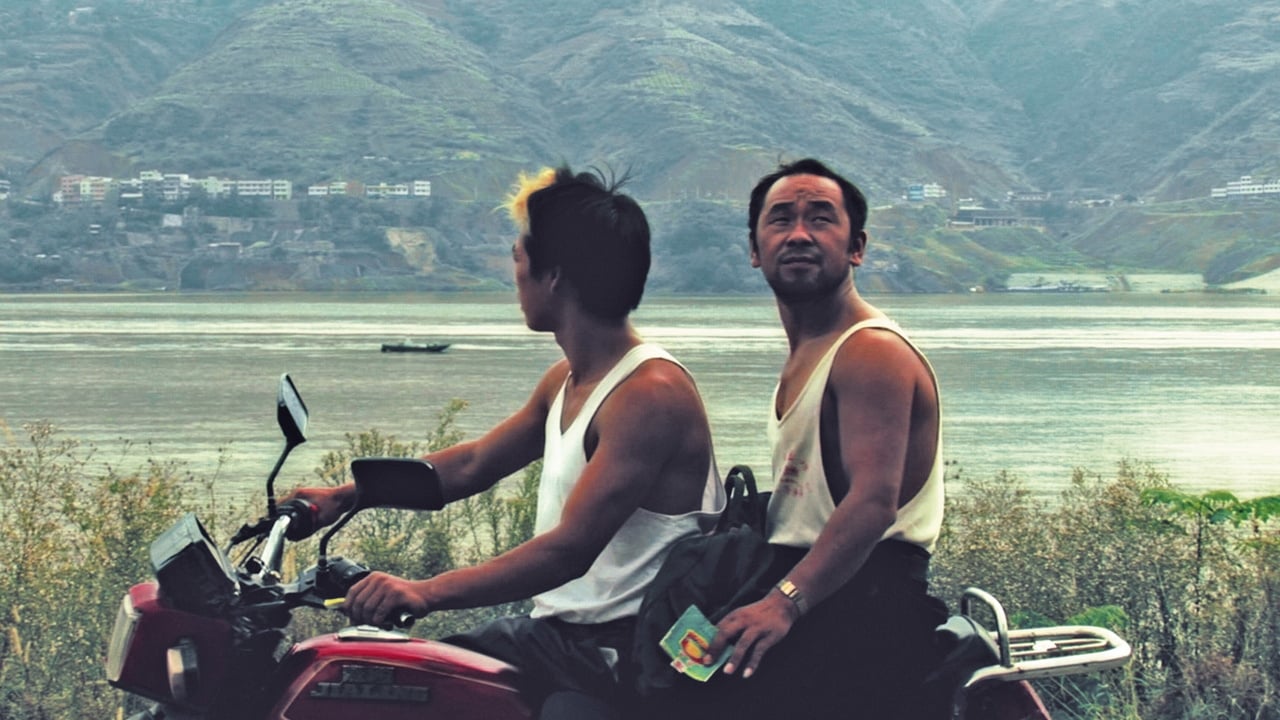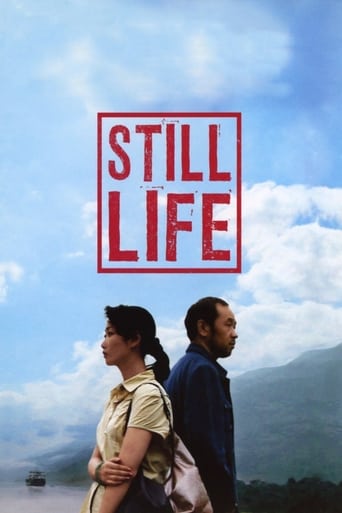

The film is shot in and around Fengjie, a town in Sichuan Province upstream from the 3 Gorges Dam Project and due to be flooded. The existing town was being demolished and the people relocated to "new Fengjie". The landscape of the river and the Gorges dominate the filmThe film follows 2 stories. Sanming is a coal miner from Shanxi who comes to Fengjie to try to find his ex wife who ran away 16 years previously. He wants to meet their daughter. He locates her brother on a ship in Fengjie who advises him to wait until his wife's ship returns. He joins a gang of labourers demolishing buildings and lives in a boarding house while waiting for his ex wife.Shen Hong is a nurse whose is trying to track down her husband Guo Bin who came to Fengjie 2 years ago. She has someone else in her life now and tracks down Guo Bin through his friend Wang Dongming so she can persuade him to divorce her. These stories run in parallel with each other but the characters never meet.The photography and the pace of the film make the viewer slow down and look for details as the camera unhurriedly pans across a vast landscape. The view is of the river dominated by precipitous hills, with the blocky concrete shapes of modern housing clinging to the slopes. In the context of the Three Gorges Dam project, a vast undertaking affecting millions of people, so the camera captures the vastness of the landscape that humans are struggling to tame. The landscape is a constant and oppressive presence that refuses to go away. The river flows on regardless of what people do.The characters are frequently filmed simply in front of the camera with the view of river and hills in the background maintaining the feeling of the vastness of nature and the smallness of people, reminiscent of the style of traditional Chinese ink painting.When scenes change away from landscapes, the people are framed up in the empty windows of abandoned houses, overlooking demolished buildings, or up against piles of rubble. The chaos of demolition contrasts with the efforts of the people to maintain the routines of their lives, eating, working, sleeping, socializing. The camera in its slow long takes of people looks for details in their lives. These are not heavily made up characters, in fact they are shown just as they are with the rough hewn physiques of manual labourers, bad teeth, scars from the school of hard knocks. The camera lingers like an observer on individuals, allowing the audience time to get to know them and their mannerisms.The dialogue between the personalities is sparse and reticent, with long pauses in which all the unspoken questions are aired and acknowledged. An example of this is the conversation between Sanming and Missy Ma when they meet after 16 years of separation. In this brief exchange this couple find they still have a future together. The undercurrent in these conversations is like the undercurrent of the river, hidden but acknowledged and always moving on. Further on in a scene in a derelict building Ma offers Sanming a White Rabbit toffee which he accepts bites in two and share it with her. With this simple gesture they agree to reactivate their relationship. As they do, suddenly a tall building in the far background is blown up and collapses, suggesting the end of the old and the potential for a new start.The soundtrack compliments the film and provides reminders of themes. A traditional song plays as the tourist ships moves up through the Gorges but it is interspersed with the sounds of demolition. The background to the characters is punctuated by horn blasts from ferries and ships moving out, a scene of labourers hammering down walls has a soundtrack of machinery overlaid onto it. The soundtrack maintains the pace of the film giving the audience a feeling of relentless movement, of the progress of events. In the interaction between the couples, romantic music is heard.The film is rich in symbolism. The characters for liquor, tea, cigarettes, and toffee appear at critical junctions and mirror traditional Chinese elements of life like rice, cooking oil, fuel and salt. Attributed to "Chinese Wasteland" by Shelley Kraicer http://www.cinema-scope.com/cs29/feat_kraicer_still.html accessed 07/09/2010There is a scene where Shen Hong walks past men are rhythmically hammering to no purpose at an abandoned industrial plant. Both Sanming and Shen Hong in their quest for resolutions to their respective relationship problems encounter a young boy wandering aimlessly singing a romantic songThe director wanders into the surreal at times, with the appearance of a UFO streaking across the sky behind Shen Hong. In the restaurant where Sanming waits for his friend, there is the incongruous sight of actors in full Chinese Opera costumes playing Nintendo games The strange building Hong can see from Wang Dongming's apartment, suddenly becomes a rocket ship and blasts off when she turns away, and, at the end of the film as Sanming and his friends are leaving, he turns and sees the incongruous sight of a high wire artist walking a wire strung between two buildings in the process of demolition.Dominant impressions I got from this film were a sense of the vastness of China and Chinese society, the smallness of the humans on the landscape, the relative insignificance of their hopes and dreams. Progress seems like a juggernaut, relentlessly moving onward, pushing aside the people and their hopes for a good life. The river serves as a metaphor for progress. The illuminating factor is the quiet courage of the people as they deal with the circumstances they have to live with, and despite these adverse times push on with their efforts to have a good life.
... View MoreThis was shot on a most incredible location ever to be filmed at. Which alone could make the film, not just visually, but by its deep surreal meaning - and it did. However, anything director tried to do only clumsily messed it up in several occasions, not showing a feeling for the whole, let alone a command of the film language.Guiding the flow in such slow tempo usually demands absolute scrutiny of every shot, since audience has a lot of time to devote to it. Here I am under impression that there's a lot of ordinary, ballast newscast like footage mixed in with some meaningful and emotional imagery. If realism was the goal, then what's the purpose of 2 isolated appearances of UFOs? (Please!)Film is divided into 4 "chapters" (cigarettes, liquor, tea, sweets) - which really don't mark anything in the story flow and are imposed by some packaging obsession. The meaning of these 4 things (explained in an interview) isn't readable not only to most international audience, but, I suspect, even some domestic viewers.All in all, a very powerful location. Too powerful for Zhang Ke Jia's weakness, pretentiousness, and scattered mind not able to put its concepts on screen.
... View MoreI think this is an outstanding movie.Having lived in China for the last 3 years, I've not seen a movie that so completely encompasses the reality of life here. The sounds, the smells, the touch of real life saturates this film.For Sinophiles everywhere this is a must-watch movie.China aside, the cinematography feels like a work of art. The slow panning camera, the oblique angles, the over long lingering of the camera on the scenes, the moments of surreality in what is otherwise a movie grounded in the "real", the beautiful stills etc...The movie is full of humanity and compassion, great depth and emotion.More people should watch this!
... View MoreThough perhaps 'Still Life'/'Sanxia haoren' (the Variety reviewer thought so) is primarily for the Jia devotee or the festival-goer (it's already been awarded the Golden Lion at Venice) and certainly it's totally noncommercial, it's a lovely, hypnotic piece of work, another haunting picture of the vast creation, disruption, destruction that is modern China from that country's most exciting and original younger-generation filmmaker.There are layers of irony in the title, because in the incredibly turbulent, ceaselessly active events on screen in this world of life that is anything but "still," the most amazing images slip by without comment. A construction boss on a rampart one evening cell-phones a technician and says, "The VIP's are here. Why aren't the lights on? I'll count to three; then turn on. One, two, three. . ." and a huge bridge and arch are suddenly illuminated behind him. One of the two estranged couples the film follows to tentative reunions is talking with a vast city behind them and in the background a big skyscraper suddenly, silently collapses. There is no comment. It just miraculously happens. In the final shot, amid the debris of the Three Gorges where the world's largest dam will eventually displace 1.4 million people, Han Sanming (non-actor Han Sanming's actual name), a mine worker who's come to find his wife and daughter, who left him sixteen years ago, stands looking out at the urban landscape and a trapeze artist is quietly walking across a tightrope between tall buildings. Again, no comment.Han Sanming can't find his wife right away and her brother doesn't trust him at first, so he stays for months, working with the brother in demolition. A perky young fellow, who quotes John Wu star Chow Yun Fat and imitates Hong Kong gangster gestures, befriends Han Sanming and they put each other's numbers in their cell phones--a contemporary pledge of solidarity that has a sad sequel later. The young fellow, who could easily have been one of the lost, hopeful young men in Jia's 2002 Unknown Pleasures, is lost in a demolition accident and gets a sea burial like the one accorded to Johnny Depp's character in Jim Jarmusch's Dead Man.Focused on the displacement of people for a vast industrial and engineering project, Still Life also contrasts classes--the humble working-class stiff who can make 50 yuan a day pulling down walls or 200 going down in a coal mine not knowing if he'll come back out, versus the handsome lady, Shen Hong (Zhao Tao) whose estranged building magnate husband she wants to divorce because she's found a younger man. She has options; Han Sanming is simply drifting and lonely. And in the background for both, though, is the enormous turbulence and activity in which we see both protagonists as tiny helpless figures, their own lives indeed "still life" by comparison.There's another unexpected, astonishing sequence of a fat rock singer, naked from the waist up like most of the Three Gorges demolition workers Han Sanming encounters and drenched in sweat. He sings of nostalgia for his youth, a time when everybody was happy , and old men in the audience shed tears while garish go-go girls gyrate: where does this fit in? This is another symbol of social upheaval. But what is really happening? Won't Chinese society have to return to its heritage of Mao and the Eighties aftermath chronicled in another of Jia's unwieldy masterpieces, the 2000 Platform? Perhaps the titles Still Life ironically points to the way people are frozen in isolation (broken couples, estranged children) and unhappiness (or quiet desperation) in a China that all the rampant economic progress both masks and perpetuates.After his colorful land pointed but somewhat leaden 2004 The World/Shijie Jia Zhang-Ke has shown again as in Platform and Unknown Pleasures that he can touch and astonish. The human events are dwarfed by capitalist Progress in the new China, but people (after all, they are a zillion of them there) are still very much in the foreground. \Still Life is an impressive, organic-feeling movie that refers to Jia's earlier films but, extraordinarily, seems to bring together both post-war Italian neo-realism and the desolate urban landscapes of Michelangelo Antonioni.Seen in Paris, October 21, 2007 at the MK2 Hautefeuille.
... View More